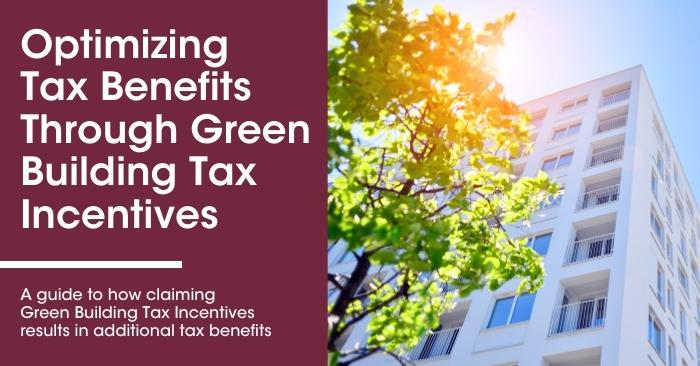Optimizing Tax Benefits Through Green Building Tax Incentives
A guide on how claiming Green Building Tax Incentives results in additional tax benefits
With more building owners and designers constructing commercial and residential buildings that meet the energy-efficiency standards to qualify a project for Green Building Tax Incentives, candidates should also know what other opportunities for additional tax benefits those projects also qualify for. These cost-saving measures drastically impact one’s bottom line and can be generated through other tax incentive programs.
Through various other government tax benefits, individuals and businesses seeking to claim Green Building Tax Incentives can create added funds and increase cash flow to be reinvested elsewhere. Claiming specific sustainability tax incentives can continue bringing value beyond a building’s reduction in energy consumption simply by knowing how to identify the trigger points of a project that warrants eligibility for a different tax program that generates excess funds.
Research & Development Tax Credits
Aimed at sparking originality for those developing new processes, the Research & Development (R&D) Tax Credit is a powerful incentive. It has proven valuable when claimed alongside other Green Building Tax Incentives and provides financial rewards for the time and expenses invested in developing innovative designs that make a building more environmentally friendly.
While traditional research-based industries primarily benefit from this program, architecture and engineering firms committed to creating innovative designs that reduce a building’s energy consumption can also qualify for the R&D Tax Credit. By designing an energy-efficient building, a firm that claims a Green Building Tax Incentive, like the 179D Tax Deduction, may also be eligible for the R&D Tax Credit if a new process for developing that design is established.
Cost Segregation Studies
With its primary purpose being to serve as a way for building owners to accelerate eligible depreciated deductions, performing a Cost Segregation study when claiming Green Building Tax Incentives acts as an avenue to claim additional tax benefits. Simply reclassifying assets within a building into shorter recovery periods through a Cost Segregation study can significantly reduce one’s taxable income and increase cash flow for future investments or projects.
When claiming a Green Building Tax Incentive, like the 45L Tax Credit, Cost Segregation studies are particularly beneficial for multifamily and affordable housing developers, and certain property owners, constructing energy-efficient buildings. By incorporating a Cost Segregation study into the financial planning process, components and materials used to improve the building’s energy efficiency are depreciated on a faster timeline, which results in lowering one’s tax liability.
Combining Other Benefits with Green Building Tax Incentives
As the movement for constructing green buildings that reduce energy consumption gains more traction, building owners, designers, and others involved in these projects should know how to maximize Green Building Tax Incentives through other initiatives. With programs like the Research & Development Tax Credit and tax-saving strategies like Cost Segregation studies, these cost-saving measures require careful planning and analysis from credentialed professionals.
Maximizing sustainability tax benefits requires a thorough understanding of the available options to develop a strategic approach, which is why candidates should consult with a tax professional like KBKG. With industry-leading experts and licensed engineers on staff, KBKG helps clients navigate through this process by guiding them to identify all the tax-saving opportunities that qualifying Green Building Tax Incentives are also eligible for.


